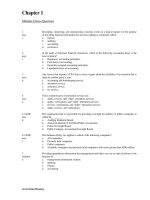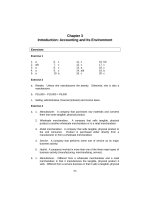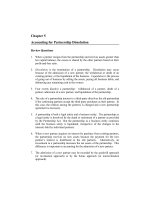Solution manual fundamentals of accounting by cabrera chapter 02 SM
Bạn đang xem bản rút gọn của tài liệu. Xem và tải ngay bản đầy đủ của tài liệu tại đây (44.86 KB, 2 trang )
Chapter 2
Partnership as a Form of Business Organization
Review Questions
1. A partnership may have a greater ability to attract capital because it is
characterized by unlimited liability. The individual partners are jointly and
severally liable. Unlike a corporation, unsatisfied partnership creditors may
gain access to the net personal assets of the individual partners.
2. Under the proprietary theory, the partnership is not viewed as a separate,
distinct entity, but rather as a conduit through which the individual partners
operate. This would explain why the partnership is not a separate taxable
entity and why the partnership income is instead taxed at the individual
partner level. The proprietary theory also explains why the basis of assets
contributed to a partnership remains the same as when held by the individual
partners. Because the partnership is not viewed as a separate entity, the
assets contributed have theoretically not been transferred to an outside
independent party, and therefore the basis is unchanged.
3. If the articles of partnership do not specifically address the allocation of
profits, the profits will be divided equally among the partners. This may
cause an inequitable division of profits if one partner is contributing services
to the business.
4. A partnership would not include partner salaries or income taxes as expenses
in the determination of income. These expenses are included in the income
of a corporation and would have to be adjusted in order to compare the
businesses.
5. Another name for the partnership agreement is the articles of partnership.
Eight items that it should specify are:
a.
b.
c.
d.
e.
f.
Name, location, and nature of the business.
Names, capital investments, and duties of each partner.
Method of sharing profits and losses by the partners.
Withdrawals allowed to the partners.
Procedures for settling disputes between the partners.
Procedures for admitting new partners.
2
Chapter 2
g. Procedures for settling up with a partner who withdraws from the
business.
h. Procedures for dissolving the partnership.
6. Mutual agency describes a partner’s ability to obligate the business to a
contract.
7. If the business cannot pay a debt, the partners must. Unlimited liability
describes the personal obligation of the partners.
8. A partnership pays no income tax on its business income. Partners pay
income tax as individuals on their shares of partnership income.
9. The great advantage of a partnership is that it combines the capital, talents,
and experience of two or more persons. Also, a partnership pays no business
income tax.
A disadvantage is that as partners enter and leave the business, the
partnership must be dissolved and reformed. Drawing up a new partnership
agreement of each new partnership may be expensive and time consuming.
However, the principal disadvantages of a partnership are mutual agency and
the unlimited personal liability of partners for business debts. A dishonest or
unwise partner can cause trouble – even the financial ruin of the other
partners.
Multiple Choice Questions
1. A
2. C
3. D
4. C
5. D
6. C
7. D
8. C
9. C
10. C









